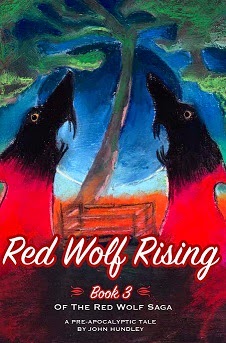The Real Red Wolves
The term red
wolf must have been floating around in my subconscious when I conceived of
Clifford Crane, the supernatural werewolf protagonist depicted in my Red Wolf Saga. Crane (you can check out
the “My Books” tab), whom I imagine to be a cross between an Irish setter and
an eight foot grizzly, bears little resemblance to the coyote-colored canid
that once roamed the eastern North American continent in large numbers a few
hundred years ago.
But, yes, there are real red wolves! And it wasn’t until I was almost ready to publish The Draculata Nest that I discovered they
are living practically in my own back yard.
Like its grey wolf cousin, which already haunted the
dreams of European settlers, the red wolves were regarded as everything from a
threat to domestic livestock to agents of Satan. The “new Americans” went about
systematically destroying the wolves’ natural habitat and hunting it to near
extinction. Today, Canis rufus can be
found living in the wild only on the Albemarle Peninsula of eastern North
Carolina, the result of an intense recovery project managed by the United
States Fish and Wildlife Service.
When I realized real wolves hunted in forests
only a few hours’ drive from my Charlotte home, I couldn’t help myself. First
chance I got, I made a road trip on the pretense of “research for the next
book,” imagining I might somehow get a glimpse of this legendary creature by
hiking around the Alligator River Wildlife Refuge.
Good luck with that, John. Mosquitoes the size
of quarters kept me inside my vehicle and off the trails, and although I saw
plenty of wildlife as I drove over the many dirt roads that crisscross the refuge,
including several black bear sightings, it would have been highly unlikely to
run across the elusive predator I later found was notoriously skittish of human
contact.
The trip wasn’t a total loss, however. I ended
up using the refuge as the setting for much of both The Dragon of Doughton Park and
Red Wolf Rising. But my subsequent research on red wolves has been done
primarily on the internet and, most recently, by way this book:
T. Delene Beeland’s The Secret World of Red Wolves, chronicles the story of the federal
Fish and Wildlife Service’s successful efforts to rescue Canis rufus from the brink of extinction after it became one of the
first species to be put on the Endangered Species list back in the 1970’s. It
is one of the finest examples of scientific journalism I’ve read. I highly
recommend it, both for the heart-warming/wrenching story behind the recovery
project and for the extensive bibliography that comprises a full quarter of the
book.
If you read it, I promise you’ll be inspired by
the perseverance of the individuals who dedicated much of their lives and
careers to try and save this creature. If you’re like me, you’ll probably fall
in love with Canis rufus. And, if
you’re like me, your heart will come away a little more broken.
Sadly, the red wolf recovery project has become
somewhat a victim of its own success, and the creature that was miraculously
saved from the brink of extinction over the last few decades will likely
disappear by way of the same threats that originally endangered it, shrinking
natural habitat and hybridization with the smaller, more prolific coyote, which
has an adaptability akin to the cockroach.
But, the most immediate threat to red wolves is
North Carolina politics. Nowhere in the nation is the current polarization of
political opinion in our republic more evident than in my beloved Tarheel
state, where blacks, whites, Hispanics, Arabs, Jews, and Asians live together
in harmony, but conservative, Bible-thumping Republicans fight latte-sipping
liberal Democrats to the death in vitriolic, economy-depleting election campaigns.
In my books, I blame the political polarization
and legislative gridlock on vampires. Sometimes I wish my little fantasy
conspiracy theory were true. It would be so much simpler to deal with.
Unfortunately, the political divide here is more complicated, and Canis rufus is just another innocent
victim of it.
Since its inception, a critical factor in the
success of the red wolf recovery program has been the ability of key
individuals who perform the day-to-day field work to form good faith, working relationships
with local landowners. The folks who own and manage red wolf habitat land on
the Albemarle Peninsula are savvy enough to recognize the benefits of the
ecological niche this larger predator provides, but they are extremely
resistant to government or any outside dictates on how to manage what is
theirs.
A recent lawsuit brought by
well-meaning-but-ultimately-misguided red wolf supporters to change hunting
regulations in the area has created a wedge between local landowners and
managers of the recovery program. Conservative political lobbyists have pounded
on that wedge to the point where it is nigh immovable. The good-faith,
handshake deals program workers have made with the locals have become null and
void in almost every case.
When I had a chance to attend a presentation by
author Beeland recently at our local community college, I asked her if she
thought the program managers/landowners relationships could be repaired. The
emotion in her voice was evident as her scientific objectivity crumbled. There
was a note of despair in her tone when she answered the prognosis was “not
good.”
The federally managed recovery program on the
Albemarle Peninsula will soon be turned over to the state of North Carolina,
whose plans to “manage” the program include little more than studying the
animal as it rapidly becomes extinct.
Alas, most of us will never see a true red wolf.
Even the ones on display in zoos and preserves are likely not true Canis rufus, but more likely a mostly
wolf/coyote hybrid. So, in the meantime, join me in a brief lament. Click on
the YouTube link below, raise your snouts, and join some red wolves in a farewell
howl…





Comments
Post a Comment